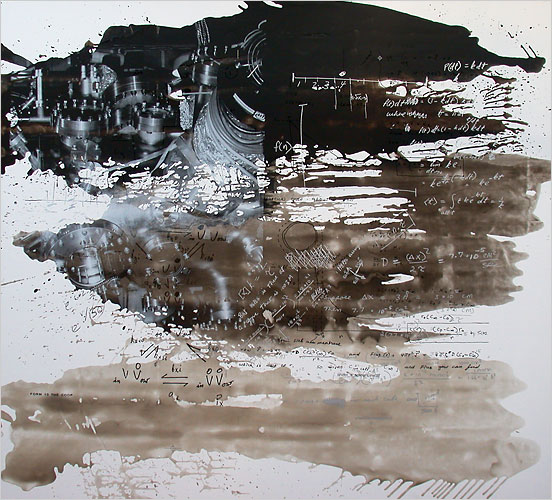

Steve Miller - Technical Divide.
By BENJAMIN GENOCCHIO
Published: March 2, 2008
Given the increasing role of genetic technology in the world, it’s not surprising that artists have begun to pay attention to its potential impact on medicine, the body and all organic matter.
The 13 artists whose work makes up “I Dream of Genomes” at the Islip Art Museum examine cloning and genetically altered food, animals, viruses and cells. But rather than just celebrating scientific advances in these areas, they employ a range of art styles and image-making techniques to confront us with the social, ethical and moral dilemmas raised by this sort of research.
The title is a play on the 1960s sitcom “I Dream of Jeannie,” about a woman who is a genie with magical powers to create and transform anything or anyone. Some scientists may feel they have similar powers these days, and maybe they are right, for who can forget the news media sensation surrounding Dolly the cloned sheep?
The question addressed here is: Just how safe and reliable is our ability to make clones? For Kate Clark, the future is uncertain; at least, that is one reading of her life-size, mixed-media sculpture of an antelope with a partly human face near the entrance to the main gallery here. A rather awkward and unhappy-looking beast, it is a reminder of how things can go wrong.
For some, the idea of cloning humans is equally worrisome. Jake Rowland imagines what this may be like, morphing photographic portraits of himself and his wife to create mutantlike figures. When one looks at the faces of the people in these photographs, their gender and age are difficult to determine. Mr. Rowland’s portraits depict a world in which identity has become fragmented and skewed.
Andrea Cote experiments with her own facial features using a variety of image creation and manipulation techniques. In a video, we see her face morphing and fluctuating in and out of focus as she explores the many possibilities of her facial structure.
But the real surprise of the exhibition is a work so bizarre in design that it alone probably compels a visit. That is a live feed via the Internet from a chicken coop at the Southampton home of the artist Hope Sandrow. Visitors are invited to ogle her baby birds, the progeny of a Paduan rooster that followed her home one morning. Soon after, the rooster found love.
None of this would be of any substance were it not for the fact that of the chicks that popped out of the eggs in Ms. Sandrow’s coop, one had the rooster’s coloring, two had the hens’ coloring, and the other three resembled neither the rooster nor the hens. It is all rather interesting.
Mathematical structures and equations inspire a broad group of artists, among them Steve Miller, Meridith Pingree and Julia Condon. Ms. Pingree is a standout with her sculptures made of tangled clothing zippers, which remind you of a double helix. They are installed in the main gallery, though not very well displayed, suspended above a mantelpiece over a fireplace. They really needed to be put on a plinth.
Several artists focus on the intricacies of genetic information, including the human cell structure and DNA sequencing. Michelle Hinebrook and Lisa Kellner both make paintings and drawings of magnified skin, tissue and hair follicles. Some visitors may find this repellent, but it is also fascinating to see that our bodies are made up of such a complex weave of microscopic cell structures.
Kathleen Kucka also paints human tissue at the microscopic level, though her colorful, mazelike paintings made of layers of acrylic paint drizzled over linen are magnified and distorted to a point of near-abstraction. They are slickly produced while at the same time retaining a handmade feel. To me they are among the most complicated and compelling works in the show.
They are also incredibly beautiful, and therefore a welcome inclusion in a show that is long on ideas and rather short on artistic flair. Ms. Kucka reminds us that serious, concept-based art can also be pleasurable to view.
“I Dream of Genomes,” Islip Art Museum, 50 Irish Lane, East Islip, through March 22. Information: (631) 224-5402 or www.islipartmuseum.org.
